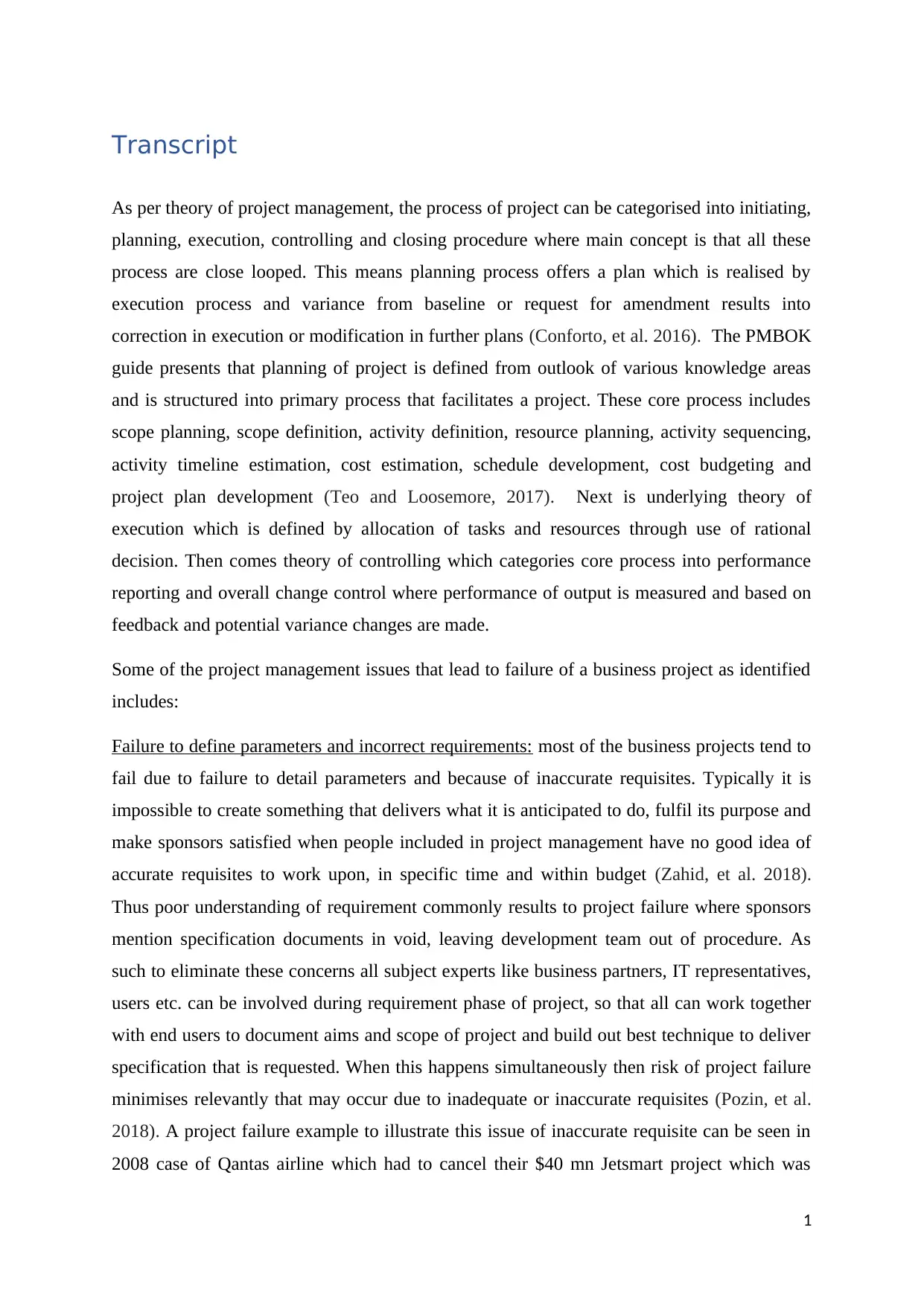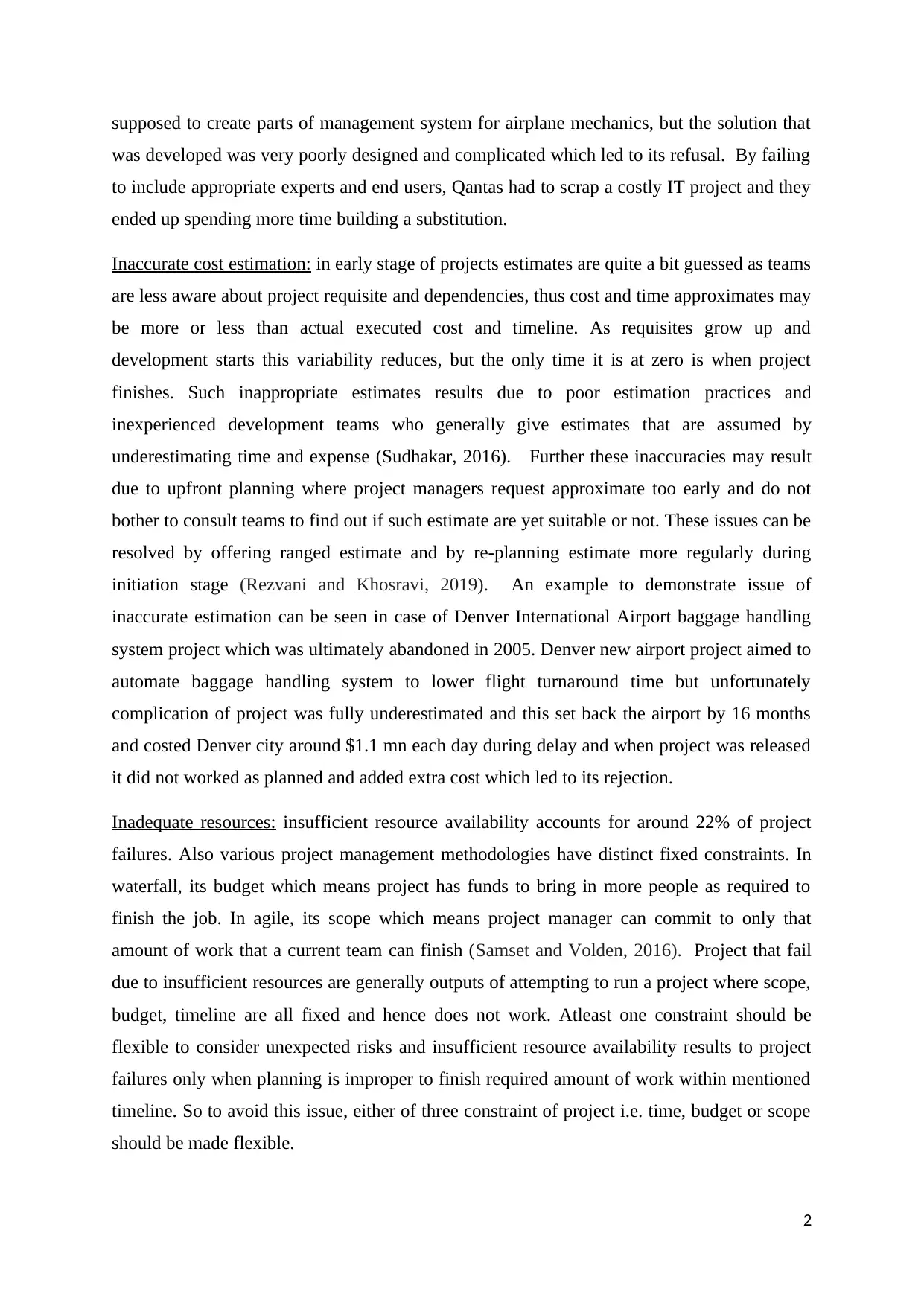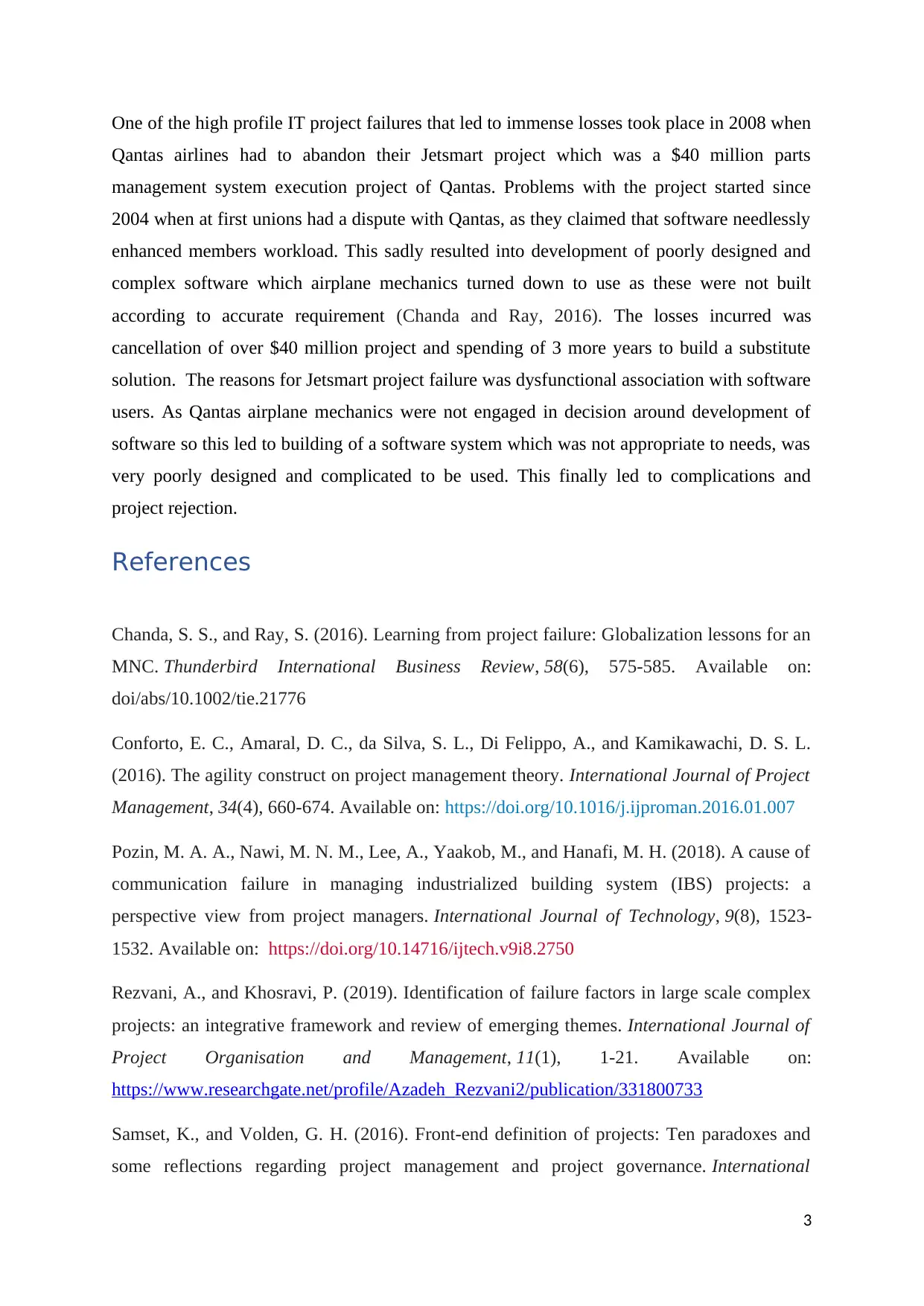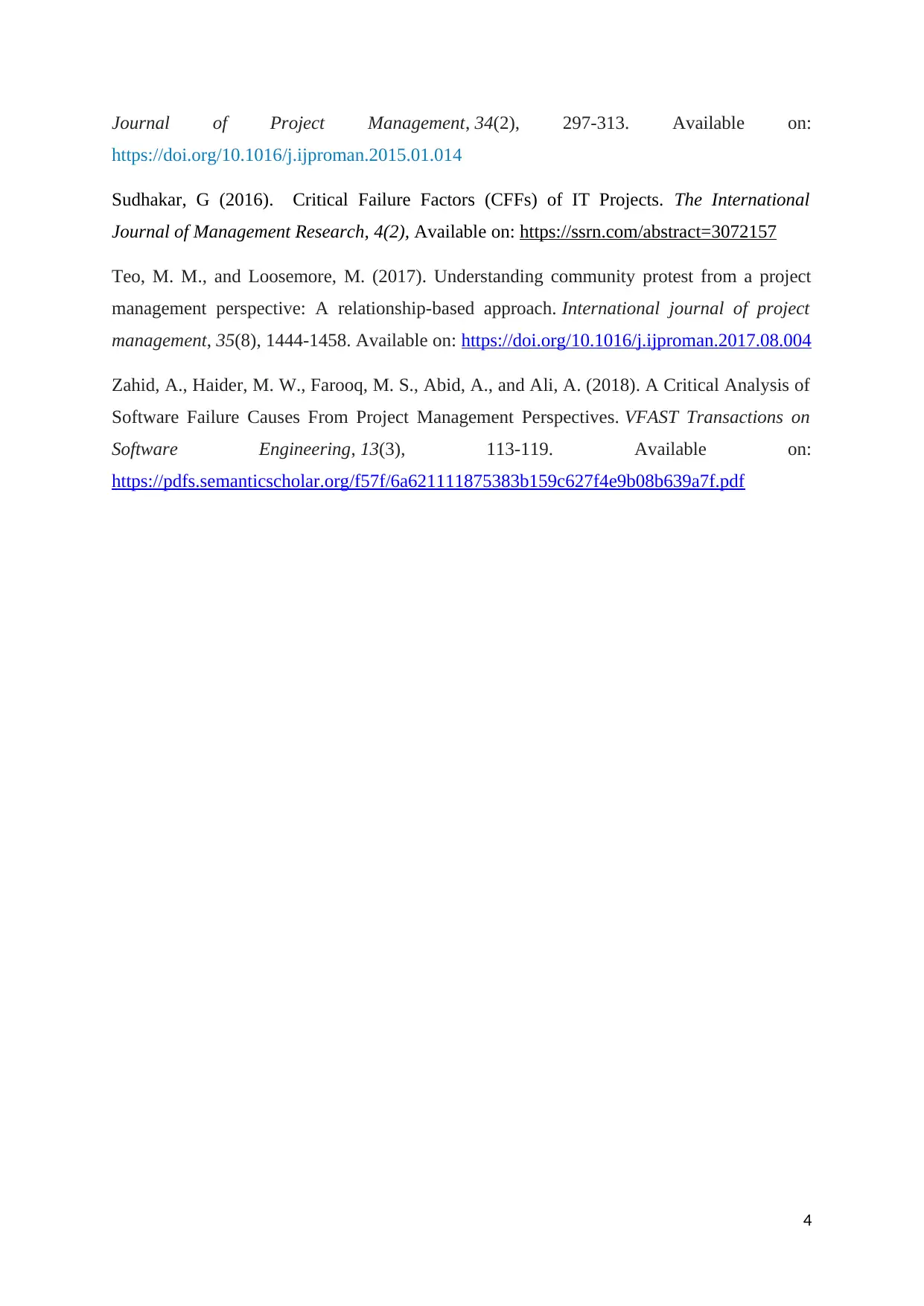Analyzing Causes of Project Failures in MCR007 Project Management
VerifiedAdded on 2022/09/11
|5
|1518
|13
Report
AI Summary
This report delves into the critical factors contributing to project failures, categorizing the project management process into initiating, planning, execution, controlling, and closing phases. It emphasizes the importance of a close-looped approach, where plans are realized through execution and variances prompt corrections. The report identifies key issues leading to project failures, including failure to define parameters and inaccurate requirements, inaccurate cost estimation, and inadequate resources. Real-world examples, such as the Qantas Jetsmart project and the Denver International Airport baggage handling system, illustrate these failures. The analysis highlights the need for proper stakeholder involvement during requirement gathering, accurate estimation practices, and flexible resource allocation to mitigate project risks and ensure successful outcomes. The report provides a comprehensive understanding of project management pitfalls and strategies for improvement, supported by relevant academic references.

MCR007
Paraphrase This Document
Need a fresh take? Get an instant paraphrase of this document with our AI Paraphraser

Transcript
As per theory of project management, the process of project can be categorised into initiating,
planning, execution, controlling and closing procedure where main concept is that all these
process are close looped. This means planning process offers a plan which is realised by
execution process and variance from baseline or request for amendment results into
correction in execution or modification in further plans (Conforto, et al. 2016). The PMBOK
guide presents that planning of project is defined from outlook of various knowledge areas
and is structured into primary process that facilitates a project. These core process includes
scope planning, scope definition, activity definition, resource planning, activity sequencing,
activity timeline estimation, cost estimation, schedule development, cost budgeting and
project plan development (Teo and Loosemore, 2017). Next is underlying theory of
execution which is defined by allocation of tasks and resources through use of rational
decision. Then comes theory of controlling which categories core process into performance
reporting and overall change control where performance of output is measured and based on
feedback and potential variance changes are made.
Some of the project management issues that lead to failure of a business project as identified
includes:
Failure to define parameters and incorrect requirements: most of the business projects tend to
fail due to failure to detail parameters and because of inaccurate requisites. Typically it is
impossible to create something that delivers what it is anticipated to do, fulfil its purpose and
make sponsors satisfied when people included in project management have no good idea of
accurate requisites to work upon, in specific time and within budget (Zahid, et al. 2018).
Thus poor understanding of requirement commonly results to project failure where sponsors
mention specification documents in void, leaving development team out of procedure. As
such to eliminate these concerns all subject experts like business partners, IT representatives,
users etc. can be involved during requirement phase of project, so that all can work together
with end users to document aims and scope of project and build out best technique to deliver
specification that is requested. When this happens simultaneously then risk of project failure
minimises relevantly that may occur due to inadequate or inaccurate requisites (Pozin, et al.
2018). A project failure example to illustrate this issue of inaccurate requisite can be seen in
2008 case of Qantas airline which had to cancel their $40 mn Jetsmart project which was
1
As per theory of project management, the process of project can be categorised into initiating,
planning, execution, controlling and closing procedure where main concept is that all these
process are close looped. This means planning process offers a plan which is realised by
execution process and variance from baseline or request for amendment results into
correction in execution or modification in further plans (Conforto, et al. 2016). The PMBOK
guide presents that planning of project is defined from outlook of various knowledge areas
and is structured into primary process that facilitates a project. These core process includes
scope planning, scope definition, activity definition, resource planning, activity sequencing,
activity timeline estimation, cost estimation, schedule development, cost budgeting and
project plan development (Teo and Loosemore, 2017). Next is underlying theory of
execution which is defined by allocation of tasks and resources through use of rational
decision. Then comes theory of controlling which categories core process into performance
reporting and overall change control where performance of output is measured and based on
feedback and potential variance changes are made.
Some of the project management issues that lead to failure of a business project as identified
includes:
Failure to define parameters and incorrect requirements: most of the business projects tend to
fail due to failure to detail parameters and because of inaccurate requisites. Typically it is
impossible to create something that delivers what it is anticipated to do, fulfil its purpose and
make sponsors satisfied when people included in project management have no good idea of
accurate requisites to work upon, in specific time and within budget (Zahid, et al. 2018).
Thus poor understanding of requirement commonly results to project failure where sponsors
mention specification documents in void, leaving development team out of procedure. As
such to eliminate these concerns all subject experts like business partners, IT representatives,
users etc. can be involved during requirement phase of project, so that all can work together
with end users to document aims and scope of project and build out best technique to deliver
specification that is requested. When this happens simultaneously then risk of project failure
minimises relevantly that may occur due to inadequate or inaccurate requisites (Pozin, et al.
2018). A project failure example to illustrate this issue of inaccurate requisite can be seen in
2008 case of Qantas airline which had to cancel their $40 mn Jetsmart project which was
1

supposed to create parts of management system for airplane mechanics, but the solution that
was developed was very poorly designed and complicated which led to its refusal. By failing
to include appropriate experts and end users, Qantas had to scrap a costly IT project and they
ended up spending more time building a substitution.
Inaccurate cost estimation: in early stage of projects estimates are quite a bit guessed as teams
are less aware about project requisite and dependencies, thus cost and time approximates may
be more or less than actual executed cost and timeline. As requisites grow up and
development starts this variability reduces, but the only time it is at zero is when project
finishes. Such inappropriate estimates results due to poor estimation practices and
inexperienced development teams who generally give estimates that are assumed by
underestimating time and expense (Sudhakar, 2016). Further these inaccuracies may result
due to upfront planning where project managers request approximate too early and do not
bother to consult teams to find out if such estimate are yet suitable or not. These issues can be
resolved by offering ranged estimate and by re-planning estimate more regularly during
initiation stage (Rezvani and Khosravi, 2019). An example to demonstrate issue of
inaccurate estimation can be seen in case of Denver International Airport baggage handling
system project which was ultimately abandoned in 2005. Denver new airport project aimed to
automate baggage handling system to lower flight turnaround time but unfortunately
complication of project was fully underestimated and this set back the airport by 16 months
and costed Denver city around $1.1 mn each day during delay and when project was released
it did not worked as planned and added extra cost which led to its rejection.
Inadequate resources: insufficient resource availability accounts for around 22% of project
failures. Also various project management methodologies have distinct fixed constraints. In
waterfall, its budget which means project has funds to bring in more people as required to
finish the job. In agile, its scope which means project manager can commit to only that
amount of work that a current team can finish (Samset and Volden, 2016). Project that fail
due to insufficient resources are generally outputs of attempting to run a project where scope,
budget, timeline are all fixed and hence does not work. Atleast one constraint should be
flexible to consider unexpected risks and insufficient resource availability results to project
failures only when planning is improper to finish required amount of work within mentioned
timeline. So to avoid this issue, either of three constraint of project i.e. time, budget or scope
should be made flexible.
2
was developed was very poorly designed and complicated which led to its refusal. By failing
to include appropriate experts and end users, Qantas had to scrap a costly IT project and they
ended up spending more time building a substitution.
Inaccurate cost estimation: in early stage of projects estimates are quite a bit guessed as teams
are less aware about project requisite and dependencies, thus cost and time approximates may
be more or less than actual executed cost and timeline. As requisites grow up and
development starts this variability reduces, but the only time it is at zero is when project
finishes. Such inappropriate estimates results due to poor estimation practices and
inexperienced development teams who generally give estimates that are assumed by
underestimating time and expense (Sudhakar, 2016). Further these inaccuracies may result
due to upfront planning where project managers request approximate too early and do not
bother to consult teams to find out if such estimate are yet suitable or not. These issues can be
resolved by offering ranged estimate and by re-planning estimate more regularly during
initiation stage (Rezvani and Khosravi, 2019). An example to demonstrate issue of
inaccurate estimation can be seen in case of Denver International Airport baggage handling
system project which was ultimately abandoned in 2005. Denver new airport project aimed to
automate baggage handling system to lower flight turnaround time but unfortunately
complication of project was fully underestimated and this set back the airport by 16 months
and costed Denver city around $1.1 mn each day during delay and when project was released
it did not worked as planned and added extra cost which led to its rejection.
Inadequate resources: insufficient resource availability accounts for around 22% of project
failures. Also various project management methodologies have distinct fixed constraints. In
waterfall, its budget which means project has funds to bring in more people as required to
finish the job. In agile, its scope which means project manager can commit to only that
amount of work that a current team can finish (Samset and Volden, 2016). Project that fail
due to insufficient resources are generally outputs of attempting to run a project where scope,
budget, timeline are all fixed and hence does not work. Atleast one constraint should be
flexible to consider unexpected risks and insufficient resource availability results to project
failures only when planning is improper to finish required amount of work within mentioned
timeline. So to avoid this issue, either of three constraint of project i.e. time, budget or scope
should be made flexible.
2
⊘ This is a preview!⊘
Do you want full access?
Subscribe today to unlock all pages.

Trusted by 1+ million students worldwide

One of the high profile IT project failures that led to immense losses took place in 2008 when
Qantas airlines had to abandon their Jetsmart project which was a $40 million parts
management system execution project of Qantas. Problems with the project started since
2004 when at first unions had a dispute with Qantas, as they claimed that software needlessly
enhanced members workload. This sadly resulted into development of poorly designed and
complex software which airplane mechanics turned down to use as these were not built
according to accurate requirement (Chanda and Ray, 2016). The losses incurred was
cancellation of over $40 million project and spending of 3 more years to build a substitute
solution. The reasons for Jetsmart project failure was dysfunctional association with software
users. As Qantas airplane mechanics were not engaged in decision around development of
software so this led to building of a software system which was not appropriate to needs, was
very poorly designed and complicated to be used. This finally led to complications and
project rejection.
References
Chanda, S. S., and Ray, S. (2016). Learning from project failure: Globalization lessons for an
MNC. Thunderbird International Business Review, 58(6), 575-585. Available on:
doi/abs/10.1002/tie.21776
Conforto, E. C., Amaral, D. C., da Silva, S. L., Di Felippo, A., and Kamikawachi, D. S. L.
(2016). The agility construct on project management theory. International Journal of Project
Management, 34(4), 660-674. Available on: https://doi.org/10.1016/j.ijproman.2016.01.007
Pozin, M. A. A., Nawi, M. N. M., Lee, A., Yaakob, M., and Hanafi, M. H. (2018). A cause of
communication failure in managing industrialized building system (IBS) projects: a
perspective view from project managers. International Journal of Technology, 9(8), 1523-
1532. Available on: https://doi.org/10.14716/ijtech.v9i8.2750
Rezvani, A., and Khosravi, P. (2019). Identification of failure factors in large scale complex
projects: an integrative framework and review of emerging themes. International Journal of
Project Organisation and Management, 11(1), 1-21. Available on:
https://www.researchgate.net/profile/Azadeh_Rezvani2/publication/331800733
Samset, K., and Volden, G. H. (2016). Front-end definition of projects: Ten paradoxes and
some reflections regarding project management and project governance. International
3
Qantas airlines had to abandon their Jetsmart project which was a $40 million parts
management system execution project of Qantas. Problems with the project started since
2004 when at first unions had a dispute with Qantas, as they claimed that software needlessly
enhanced members workload. This sadly resulted into development of poorly designed and
complex software which airplane mechanics turned down to use as these were not built
according to accurate requirement (Chanda and Ray, 2016). The losses incurred was
cancellation of over $40 million project and spending of 3 more years to build a substitute
solution. The reasons for Jetsmart project failure was dysfunctional association with software
users. As Qantas airplane mechanics were not engaged in decision around development of
software so this led to building of a software system which was not appropriate to needs, was
very poorly designed and complicated to be used. This finally led to complications and
project rejection.
References
Chanda, S. S., and Ray, S. (2016). Learning from project failure: Globalization lessons for an
MNC. Thunderbird International Business Review, 58(6), 575-585. Available on:
doi/abs/10.1002/tie.21776
Conforto, E. C., Amaral, D. C., da Silva, S. L., Di Felippo, A., and Kamikawachi, D. S. L.
(2016). The agility construct on project management theory. International Journal of Project
Management, 34(4), 660-674. Available on: https://doi.org/10.1016/j.ijproman.2016.01.007
Pozin, M. A. A., Nawi, M. N. M., Lee, A., Yaakob, M., and Hanafi, M. H. (2018). A cause of
communication failure in managing industrialized building system (IBS) projects: a
perspective view from project managers. International Journal of Technology, 9(8), 1523-
1532. Available on: https://doi.org/10.14716/ijtech.v9i8.2750
Rezvani, A., and Khosravi, P. (2019). Identification of failure factors in large scale complex
projects: an integrative framework and review of emerging themes. International Journal of
Project Organisation and Management, 11(1), 1-21. Available on:
https://www.researchgate.net/profile/Azadeh_Rezvani2/publication/331800733
Samset, K., and Volden, G. H. (2016). Front-end definition of projects: Ten paradoxes and
some reflections regarding project management and project governance. International
3
Paraphrase This Document
Need a fresh take? Get an instant paraphrase of this document with our AI Paraphraser

Journal of Project Management, 34(2), 297-313. Available on:
https://doi.org/10.1016/j.ijproman.2015.01.014
Sudhakar, G (2016). Critical Failure Factors (CFFs) of IT Projects. The International
Journal of Management Research, 4(2), Available on: https://ssrn.com/abstract=3072157
Teo, M. M., and Loosemore, M. (2017). Understanding community protest from a project
management perspective: A relationship-based approach. International journal of project
management, 35(8), 1444-1458. Available on: https://doi.org/10.1016/j.ijproman.2017.08.004
Zahid, A., Haider, M. W., Farooq, M. S., Abid, A., and Ali, A. (2018). A Critical Analysis of
Software Failure Causes From Project Management Perspectives. VFAST Transactions on
Software Engineering, 13(3), 113-119. Available on:
https://pdfs.semanticscholar.org/f57f/6a621111875383b159c627f4e9b08b639a7f.pdf
4
https://doi.org/10.1016/j.ijproman.2015.01.014
Sudhakar, G (2016). Critical Failure Factors (CFFs) of IT Projects. The International
Journal of Management Research, 4(2), Available on: https://ssrn.com/abstract=3072157
Teo, M. M., and Loosemore, M. (2017). Understanding community protest from a project
management perspective: A relationship-based approach. International journal of project
management, 35(8), 1444-1458. Available on: https://doi.org/10.1016/j.ijproman.2017.08.004
Zahid, A., Haider, M. W., Farooq, M. S., Abid, A., and Ali, A. (2018). A Critical Analysis of
Software Failure Causes From Project Management Perspectives. VFAST Transactions on
Software Engineering, 13(3), 113-119. Available on:
https://pdfs.semanticscholar.org/f57f/6a621111875383b159c627f4e9b08b639a7f.pdf
4
1 out of 5
Related Documents
Your All-in-One AI-Powered Toolkit for Academic Success.
+13062052269
info@desklib.com
Available 24*7 on WhatsApp / Email
![[object Object]](/_next/static/media/star-bottom.7253800d.svg)
Unlock your academic potential
Copyright © 2020–2025 A2Z Services. All Rights Reserved. Developed and managed by ZUCOL.





